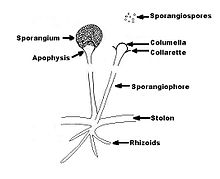Rhizopus
| Rhizopus | |
|---|---|
 |
|
| Schematic diagram of Rhizopus spp. | |
| Scientific classification | |
| Kingdom: | Fungi |
| Division: | Zygomycota |
| Class: | Mucormycotina |
| Order: | Mucorales |
| Family: | Mucoraceae |
| Genus: |
Rhizopus Ehrenb. (1820) |
| Type species | |
|
Rhizopus nigricans Ehrenb. (1820) |
|
| Synonyms | |
Crinofera Nieuwl. (1916)
Pilophora Wallr. (1833)
Rhizopus is a genus of common saprophytic fungi on plants and specialized parasites on animals. They are found on a wide variety of organic substrates, including "mature fruits and vegetables", jellies, syrups, leather, bread, peanuts, and tobacco. Some Rhizopus stolonifer
species are opportunistic agents of human zygomycosis (fungal infection) and can be fatal. Rhizopus infections may also be a complication of diabetic ketoacidosis. This widespread genus includes at least eight species.
Rhizopus species grow as filamentous, branching hyphae that generally lack cross-walls (i.e., they are coenocytic). They reproduce by forming asexual and sexual spores. In asexual reproduction, sporangiospores are produced inside a spherical structure, the sporangium. Sporangia are supported by a large apophysate columella atop a long stalk, the sporangiophore. Sporangiophores arise among distinctive, root-like rhizoids. In sexual reproduction, a dark zygospore is produced at the point where two compatible mycelia fuse. Upon germination, a zygospore produces colonies that are genetically different from either parent.
Various species, including R. stolonifer, may cause soft rot in sweet potatoes and Narcissus.
...
Wikipedia
